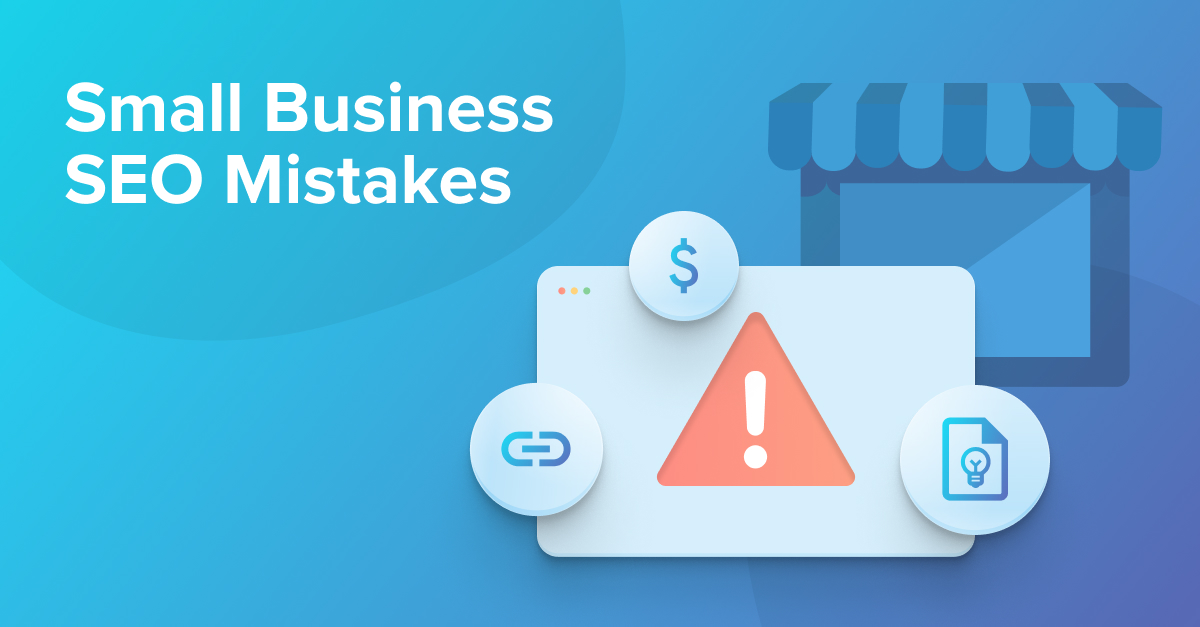
SEO is difficult for everyone but smaller businesses always face a steeper climb when starting out. Building a search presence from nothing is one of the biggest challenges you’ll face in SEO and it’s even harder if you’re dealing with limited funds and resources like most smaller businesses.
Even the best SEO strategies take time to gain momentum so you can’t afford to make unnecessary mistakes. This article will help you avoid the most common mistakes small businesses make when starting out with SEO – so you can gain traction and benefit from SEO as quickly as possible.
Table of Contents
- 1 What are the most common SEO mistakes for small businesses?
- 2 Mistake #1: Going in without a plan
- 3 Mistake #2: Thinking SEO is free or cheap
- 4 Mistake #3: Shying away from technical SEO
- 5 Mistake #4: Cutting corners with SEO ‘hacks’
- 6 Mistake #5: Building unnatural links
- 7 Mistake #6: Sending more traffic to a poor website
- 8 Mistake #7: Expecting to rank at the top of page one
- 9 Key takeaways from this article
What are the most common SEO mistakes for small businesses?
For most smaller businesses starting out with SEO, everything in search marketing will be completely new. As a beginner, you’re going to make mistakes and learn along the way. This can be a scary journey but it’s something every new business experiences so you’re not alone.
SEO has never been more complicated than it is now, so newcomers have even more to learn and experiment with than previous businesses. The majority of mistakes smaller businesses make when starting out come down to a combination of a few different things: not fully understanding the challenges of SEO, setting unrealistic targets, poor planning, and cutting corners.
This leads small businesses to make common mistakes when first starting out with SEO:
- Going in without a plan
- Thinking SEO is free or cheap
- Shying away from technical SEO
- Cutting corners with SEO ‘hacks’
- Building unnatural links
- Sending more traffic to a poor website
- Expecting to rank at the top of page one
This article explores each of these mistakes in detail and explains why they’re so common. Most importantly, it also reveals how you can avoid making the same mistakes in your own SEO strategy.
Mistake #1: Going in without a plan
Planning a successful SEO strategy is one of the biggest challenges you’ll face as a small business owner. Without a solid grasp of search optimisation, it’s difficult to know where to begin and you may not have the funds to hire an agency (like Vertical Leap) or SEO experts – or even the time to optimise your site while also running a business.
Before you dive into SEO, you need to have realistic expectations and a clear idea of what you’re trying to achieve.
This varies from one business to another – for example, an online retailer will take a very different approach to SEO than an artisan bakery that only sells in-store. While the online retailer’s time and money might be better spent on creating quality product guides, the bakery would probably want to focus on local SEO, putting most of its effort into Google Business Profile.
How can small businesses avoid this SEO mistake?
If you’re going to manage your own SEO strategy, you need to learn as much as you can about search engine optimisation. Start with the basics and get a solid grasp of the essentials (keyword targeting, on-page SEO, content quality, etc.). In the Seobility blog and wiki, you’ll find lots of helpful articles on these topics. Also, make sure that your strategy stays relevant to your business type – e.g. online, local, or a mixture of both. Check out our article on SEO strategies for different types of small businesses for more info.
Once you’re comfortable enough to get started, you’ll want to plan out four key elements of your SEO strategy:
- Goals: Specify what you want to achieve in the first year of your SEO strategy – e.g. increase online sales by 25%.
- Target audiences: Identify your SEO target audiences, detailing their needs and how these align with your business.
- Keywords: Identify the keywords you’re going to target – primary keywords, secondary keywords, long-tail keywords, etc.
- Competition: Identify your search rivals and analyse their SEO strategies to understand what you’re up against.
For step 3 and 4, Seobility’s free Keyword Research Tool can be of great help. It lets you find primary keywords to prioritise across your website and content marketing strategy, secondary keywords for sub-pages, and low-competition opportunities (e.g. long-tail keywords) that can gain traction faster.
These insights will inform your content strategy, including the most important topics you need to cover to attract traffic.
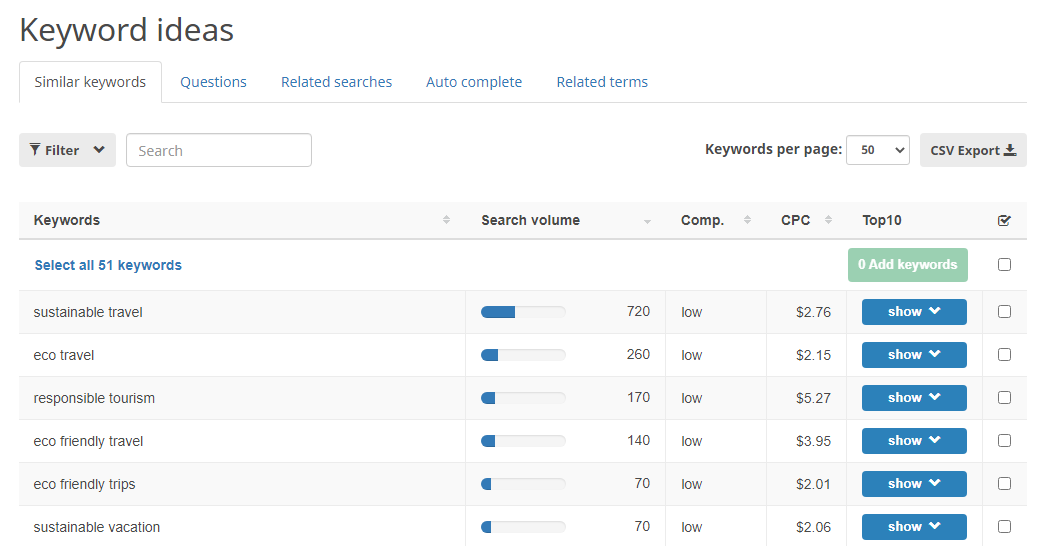
You can also identify the keywords your competitors rank for to identify gaps in your content strategy. For more information, check out this guide on how to do keyword research by Seobility.
Mistake #2: Thinking SEO is free or cheap
SEO has a history of being labelled a free or cheap marketing strategy, mainly because you’re not paying for clicks as you do with PPC. This is a dangerous misconception for smaller businesses because it overlooks the time, resources (and money) it takes to optimise pages and produce the kind of content required to build an effective SEO strategy.
It’s more accurate to say that search engine optimisation is one of the highest-ROI inbound marketing strategies.
Which #DigitalMarketing channel has the highest ROI for your website? #SEJSurveySays
— SearchEngineJournal® (@sejournal) July 23, 2018
The initial investment of time and content production doesn’t pay off right away but an effective SEO strategy drives exponential growth because the content you’ve already produced continues to generate new business leads while you continue to create new content and optimise existing pages.
As you build a stronger search presence and visibility grows, more people see your content – both new and old – and the ROI of your SEO strategy continues to increase, at a faster rate over time.
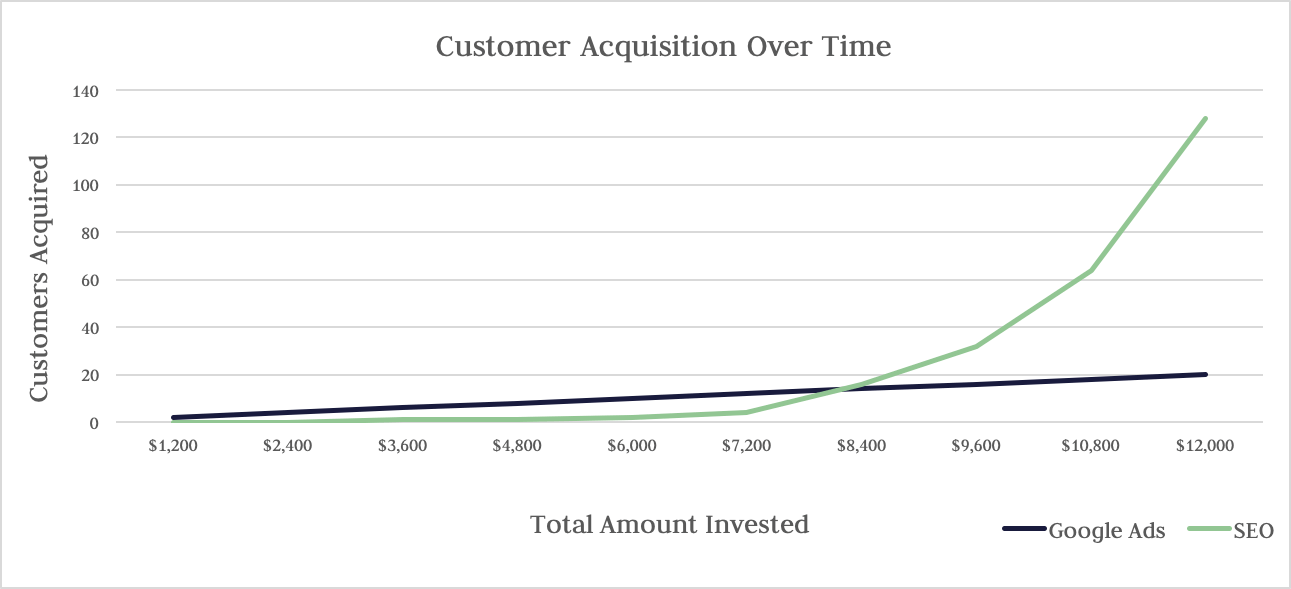
If we compare this with other channels, SEO reveals its credentials as a high-ROI strategy. For example, with PPC you’re constantly paying for ads and users can’t click on ads you’ve already paid for in the past so you see a far more gradual return as your investment increases.
Initially, you should see a higher ROI from your PPC strategy than your SEO or content marketing campaigns. But, once your SEO strategy takes off, it should rapidly outpace the ROI of most other marketing channels.
How can small businesses avoid this SEO mistake?
Ignore any suggestions that SEO is a free or cheap marketing strategy. Instead, think of it as a high-ROI channel and be ready to invest, especially in content production. It takes time and money to create quality content, even more so if you’re going to produce multimedia content.
As you can see from the line graph above, the worst thing you can do with SEO is underinvest because you’ll struggle to break the initial ROI barrier.
However, once you do, continued investment will drive exponential growth. So, before you start, sit down and calculate realistic expenses for the most important SEO tasks (page optimisation, content production, analysis, etc.) and a timeline of how much you’re going to invest in each quarter of the first year.
Mistake #3: Shying away from technical SEO
Technical SEO maintains the crawlability and indexability of your website while ensuring everything under the hood is optimised to maximise your search rankings.
First of all, this ensures Google and other search engines can find and rank your pages as quickly as possible. Next, it optimises the code and back-end aspects of your site and every page to make sure Google can access the information it needs.
Finally, it maintains the technical performance of your website (Core Web Vitals, page speed, mobile optimisation, etc.) to keep search engines and users equally happy.
The problem with technical SEO is it gets pretty, well… technical, which can make it challenging for people without coding, development, and SEO experience. Unfortunately, your website simply can’t show in search engines without it and you won’t maximise visibility without a complete, ongoing technical SEO strategy.
This isn’t something you can afford to shy away from.
How can small businesses avoid this SEO mistake?
Broadly speaking, you’ve got two possible approaches to technical SEO as a small business getting started. Either you learn the ropes and improve as you go along or you hire some help to take care of the technical stuff for you.
If this all sounds overwhelming, the good news with technical SEO is that you can automate the majority of checks that you need to run. Google provides plenty of tools for tracking page speed, Core Web Vitals, and checking your link profiles. Seobility also has a built-in website audit tool that you can use to run checks for crawling issues, broken links, and problems with title tags, headings, and a range of other elements.
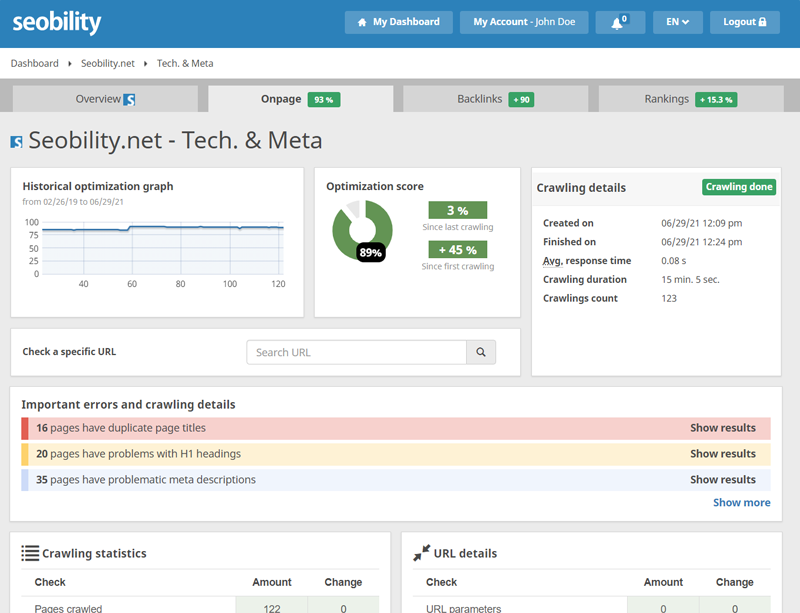
These tools will help you handle the most important aspects of technical SEO for yourself and you can always bring in outside help later on.
Mistake #4: Cutting corners with SEO ‘hacks’
It takes a lot of time and effort to develop a successful SEO strategy so it’s tempting to look for shortcuts or easy wins. This is especially true for smaller businesses which are always at a disadvantage when it comes to budget and other resources.
Even still, be careful with SEO “hacks” or any shortcuts that promise quick results because cutting corners in SEO rarely works out.
Once upon a time, link tactics like keyword stuffing and link purchasing were promoted as SEO hacks until Google cracked down with a series of algorithm updates targeting these practices.
How can small businesses avoid this SEO mistake?
The golden rule of SEO is to stick to Google’s guidelines on things like content quality and web spam. Always be skeptical about advice that contradicts these guidelines, in particular, because these are the ones typically targeted in major updates.
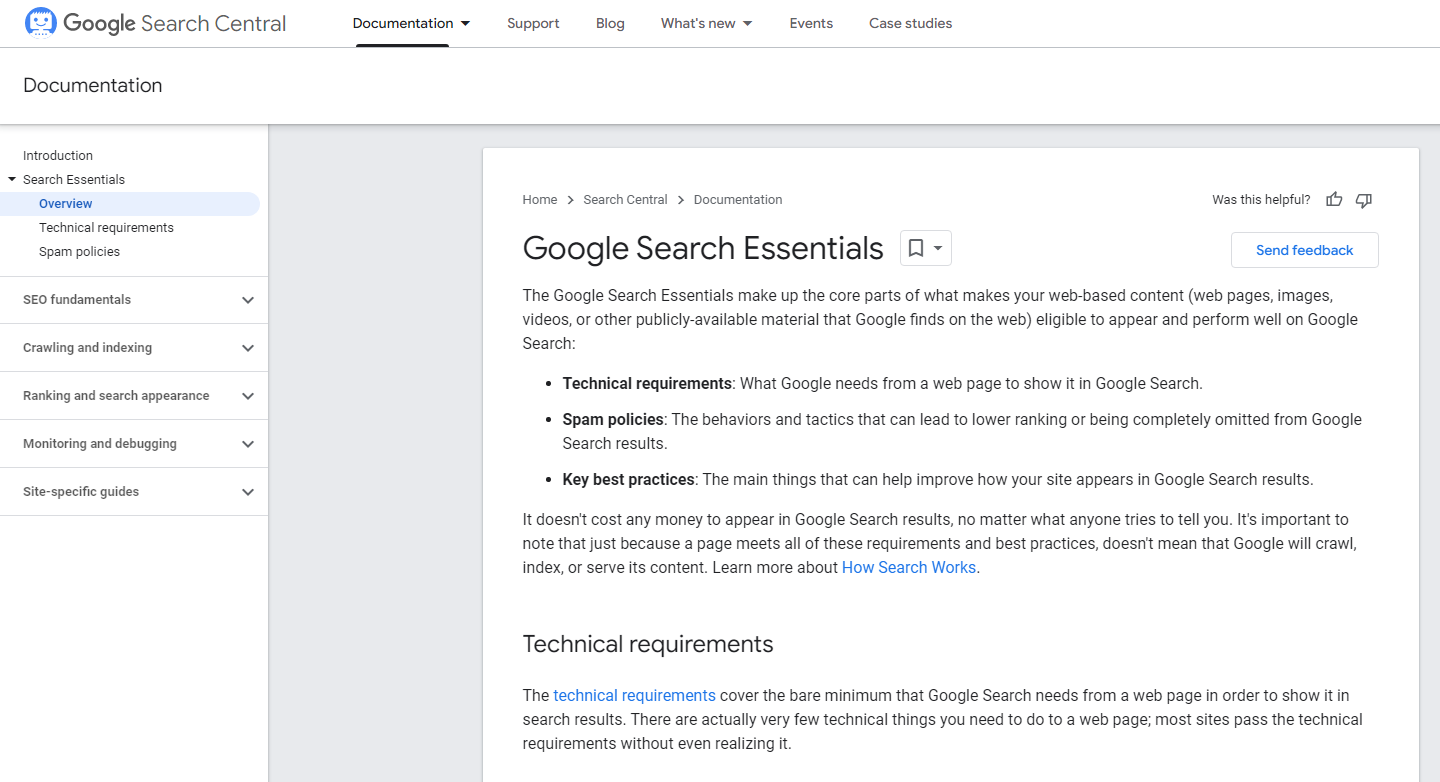
Also, pay attention when Google says things like loading times and mobile optimisation are important. Strive to be great at the core essentials (content quality, mobile optimisation, page speed, etc.) and you shouldn’t need to find quick fixes.
Once you’ve got a strong grasp of the essentials, you’ll have enough experience to differentiate between good and bad advice.
Mistake #5: Building unnatural links
Links are one of the most important ranking signals in search algorithms. Despite all of Google’s advances in AI technology over the past decade, it still relies on links as a key signal of content quality, which means link building remains an essential part of any SEO strategy.
Unfortunately, it’s also one of the most difficult aspects of SEO and it’s especially difficult for smaller businesses starting out. Major publishers have the advantages of bigger budgets, industry connections, a larger profile and a level of trust that can naturally earn links from other publishers.
As a small business, you probably won’t have any of these (yet) and it’s tempting to hustle for any links you can get early. However, it’s important to understand that not all links are equal and Google wants to see natural, relevant links pointing to your website.
You don’t want to waste time, effort (and, especially, money) on links that aren’t going to benefit your search presence.
How can small businesses avoid this SEO mistake?
First of all, keep track of your website’s link profile by using trusted SEO tools. With Seobility’s Backlink Analysis feature or Google Search Console, you can view your link profile to see who is linking to your website. In case you spot a high number of links that look problematic you can consider disavowing those links.
A problematic backlink can mean many things, but to keep things simple, you may want to start by looking at external sites where there are many (i.e. 100s, or 1000s) of backlinks from single domains or any backlinks that have explicit language or related terms.
In terms of seeking out link opportunities, you could start by targeting links from sites that rank higher than you for your target keywords (especially primary keywords).
Among these sites, there will typically be non-competing sites that are related to the topic. For example, news and media websites that have a strong brand and rank well, but rely on industry experts to provide content for them and therefore will be willing to link to those sites.
Other examples can include sites such as trusted forums which will want to link out to articles, guides and white papers from leading experts in the field.
As your search ranking improves, you continue to target higher-profile opportunities but, in the meantime, you can get your first opportunities with the following tips:
- Support your local community
- Network work with relevant, niche bloggers
- Guest post on relevant industry websites
- Be newsworthy (start locally, if needed)
- Sponsor or run events
- Interview figures at target sites (they might link back to your content)
- Analyse your competitors’ link profiles
Seobility’s backlink analysis and monitoring feature can help you find new link opportunities automatically, based on the link profiles of your competitors and relevant sites in your niche. You can also analyse your rivals’ link profiles manually to look for ideas and potential gaps that you can target and exploit.
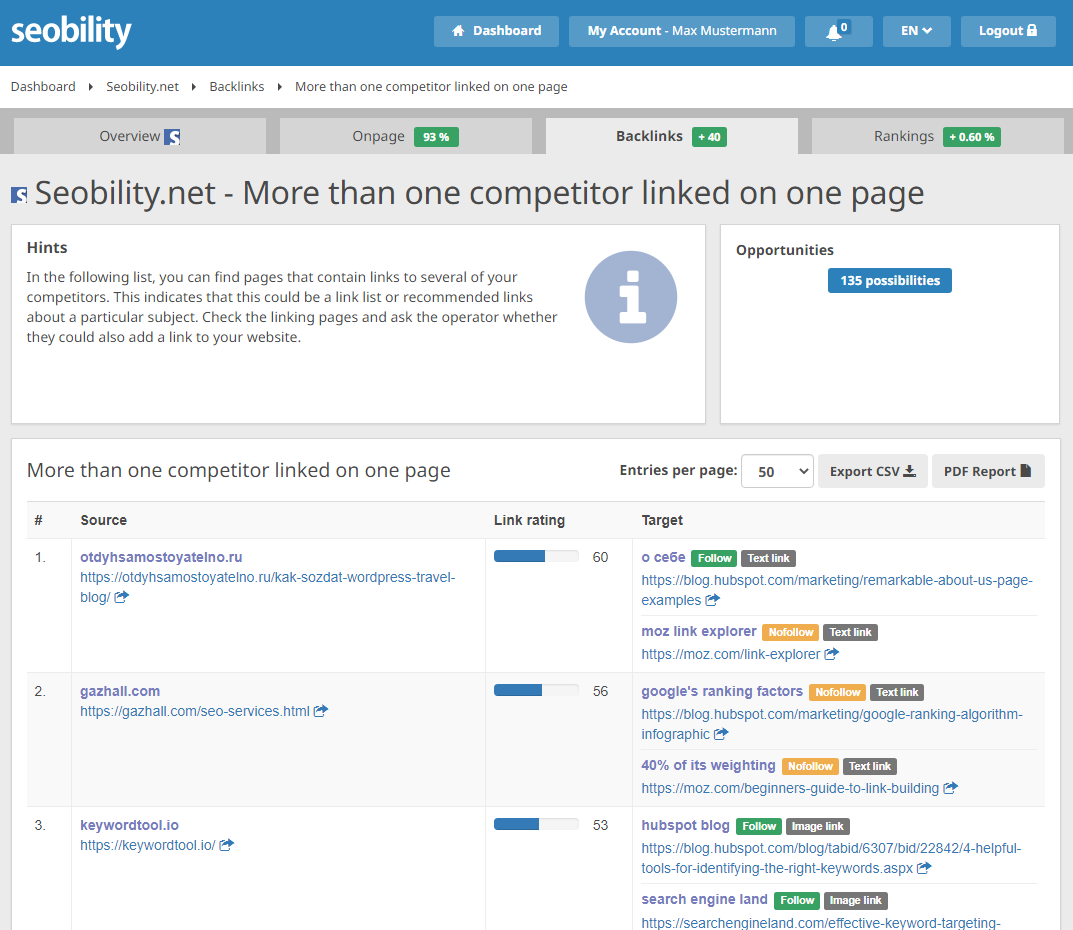
Eventually, you want to get to a point where websites are naturally linking to your pages because you publish high-quality and trustworthy content, filled with information they can share with their audiences.
An effective long-term strategy is to publish data-oriented content, such as reports filled with statistics and insights. Ideally, you would want to source unique insights that nobody else can publish through surveys and interviews so all links come back to you.
This is a big content project but it’s something to work towards as your SEO ROI increases. You can find more ideas and inspiration in this guide on how to build high-quality backlinks.
Mistake #6: Sending more traffic to a poor website
It doesn’t matter how high you rank for the most valuable keywords if visitors land on your website and hit the back button to leave right away. You can’t paper over the cracks of a poor website by simply driving more traffic to it because you’re simply going to drive more of them away – potentially forever.
According to a survey carried out by Digital.com, slow loading times are the biggest issue users experience (21%) and only 16% say they’re likely to return to a website with slow page speeds.
The report lists the following issues as the most common causes of poor user experiences:
- Slow loading times – 21%
- Security concerns – 20%
- Poor navigation – 15%
- Poor mobile optimisation – 15%
Google knows that poor UX kills the search experience so it rewards websites that not only deliver valuable content but also provide pleasing experiences.
This makes it more difficult for sites with poor UX to improve their search ranking and, as a result, maximise their traffic potential. More importantly, you’ll drive the majority of new visitors away and many of these users will never come back to your site, even if they see you on results pages again in the future.
Poor website UX is the fastest way to cancel our SEO’s high-ROI potential and make it even harder to gain traction – something that’s already more difficult for smaller businesses.
How can small businesses avoid this SEO mistake?
Make sure your website is in shape before you put all of your resources into driving more traffic. Modern SEO is as much about user experience optimisation as traditional search optimisation and you should prioritise the following UX factors in your SEO strategy:
- Loading times
- Navigation
- Mobile optimisation
- Core Web Vitals
- Quality content
- Engagement (time on page, pages per session, etc.)
- Accessibility
Modern SEO heavily overlaps with UX design with Google regularly introducing new signals like Core Web Vitals that reward pages for providing quality experiences.
Search engines need users to feel satisfied with the pages they visit through their platforms to keep them coming back. This is why Google, in particular, rewards pages that deliver the content users are looking for in an experience that keeps them interacting with the page and wider website.
With Google Analytics, you can track on-page metrics like Avg. time on page and Avg. pages per session to start building a picture of how engaging your pages are.
You can see this information in Google Analytics (Universal) by navigating to Site Content 🡪 All Pages:

Combine this with data from Google’s PageSpeed Insights tool to identify loading issues and other UX problems that could force users to leave before they interact with your content.
But note that there are many reasons why users may leave a page quickly, and not all are due to a bad technical experience.
Other examples could include:
- Not fully satisfying the relevant user intent. On an eCommerce website, this may be someone needing to see trust signals such as positive user reviews before they can commit to purchasing an item.
- Low quality or spam signals in your content putting off the user, for example, poor quality content or lots of sales pop-ups triggering people to exit the site sooner.
Mistake #7: Expecting to rank at the top of page one
A lot of business owners turn to SEO with the hopes of ranking at the top of page one for primary keywords, thinking they’ll generate all of this traffic that can’t wait to buy from them. Sadly, this isn’t only unrealistic from an SEO perspective but also in terms of how people browse and buy online.
If you want to bring traffic to your website quickly and target visitors who are ready to buy now, then PPC is the strategy you’re looking for.
SEO is a long-term strategy that builds organic visibility and makes your brand discoverable to potential customers at every stage of the consumer journey – the vast majority of whom won’t be buying today.
It takes time to build this kind of search presence and you’re not going to rank at the top of page one for any keywords overnight. It could take months or years to get anywhere near the top of page one for your most competitive keywords because you’re battling against the biggest and best in your industry for them – not to mention the likes of Wikipedia, Amazon, and major publishers.
How can small businesses avoid this SEO mistake?
Be realistic with your SEO expectations, especially as a small business starting out in a competitive space. Keep in mind that your goal isn’t to rank at the top of result pages or to generate as much traffic as possible. Your goal is more likely to increase targeted traffic (i.e. visitors who are actually interested in your products or services), build brand awareness and capture leads that are likely to buy from you in the future.
You may not need to rank in the top positions for the most competitive keywords to do this.
More realistically, you probably don’t have the funds or resources to target the top positions as a small business from the outset. Instead, you can gain early traction with a combination of strategies designed to get faster results, and build momentum over time.
Example tactics for quicker wins can include:
- Add new content to key pages to expand their reach and get in front of wider audiences – for example, define complex information and remove any educational barriers to people making contact.
- Add frequently asked questions to the base of your most important pages on your website to provide more search and user value.
- Provide image and video content to target areas within the search result pages dedicated to different content types that are often overlooked by the competition.
- Look at your competitor sites top performing content and the top-performing results in the search engines for your industry. Create more comprehensive content than those ranking at present.
- Analyse your rivals’ strategies and identify opportunities they’ve missed so you can cut through the competition.
Once you start to gain some traction, you can target more ambitious SEO objectives.
Key takeaways from this article
We’ve covered quite a lot of ground in this article so let’s quickly summarise the key takeaways. Here’s another look at the mistakes we’ve discussed and a short reminder of how to avoid them:
- Going in without a plan: Set realistic SEO goals and develop a data-driven strategy to achieve them.
- Thinking SEO is free or cheap: Invest enough in SEO to achieve exponential growth in a realistic time frame.
- Shying away from technical SEO: Choose the right tools to maintain the technical performance of your website or hire expert help.
- Cutting corners with SEO ‘hacks’: Master the basics first and gain the experience you need to differentiate the good advice from the bad.
- Building unnatural links: Earn quality links from relevant websites ranking above you for primary keywords with legitimate outreach and publicity.
- Sending more traffic to a poor website: Get your website in order before you start driving more traffic to it – this will help your search rankings and conversion rates.
- Expecting to rank at the top of page one: Gain traction faster by targeting easier opportunities and scale your SEO goals over time.
By avoiding these common mistakes, you’ll gain an advantage over most small businesses starting out with SEO and gain traction with your search marketing strategy faster. The sooner you can start building momentum, the faster you’ll generate a meaningful ROI from SEO and realise the potential to invest more and achieve the kind of exponential growth we’ve discussed in this article.
Want to learn more about SEO for small businesses? Check out the other articles in this series:
- SEO Strategies for Different Types of Small Businesses
- Content Marketing For Small Businesses: Tips And Strategies For Growing Your Online Presence
- The Essential SEO Checklist For Your Small Business
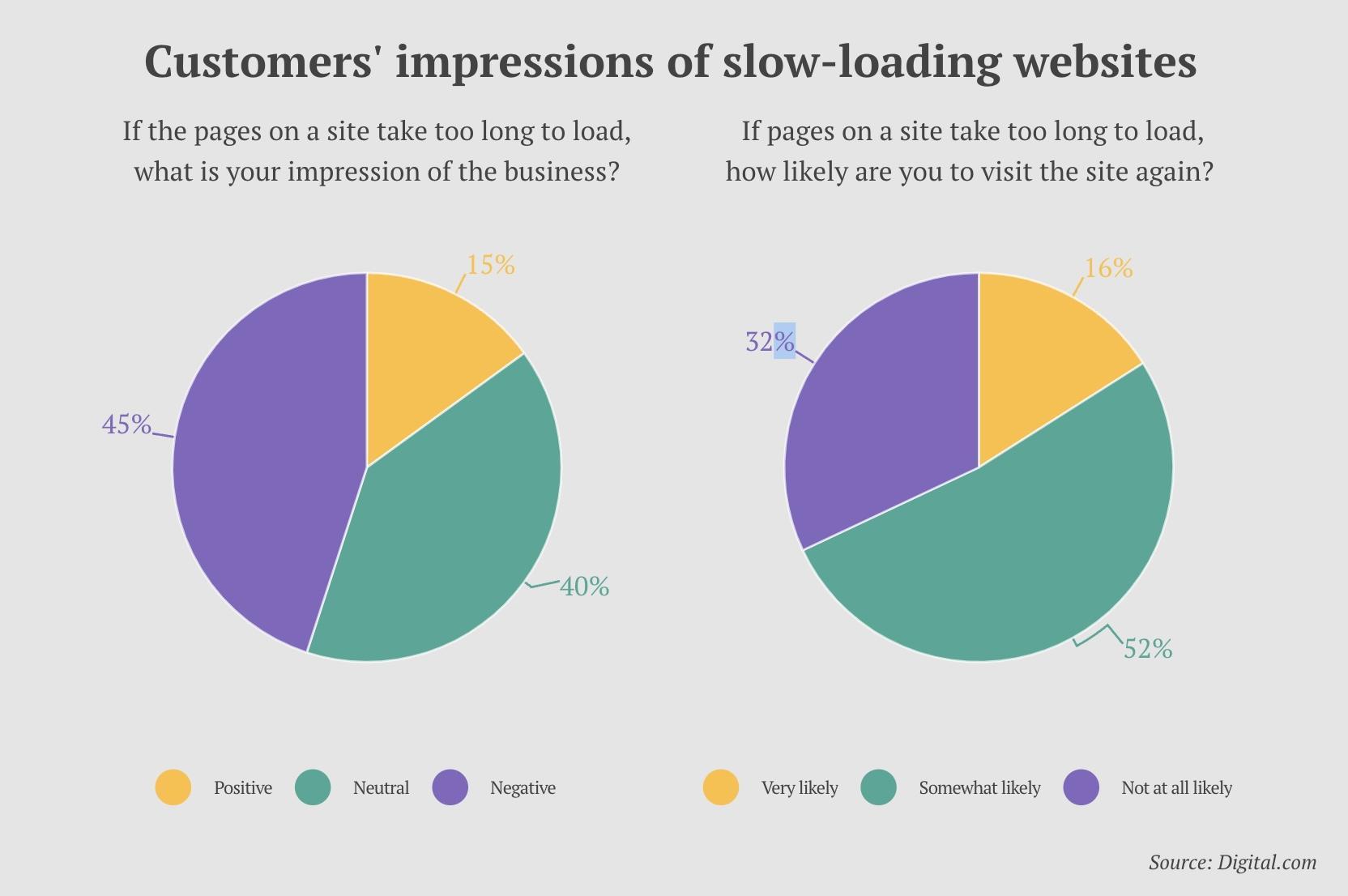
3 thoughts on “Top SEO Mistakes For Small Businesses To Avoid When Starting Out”
Hi Lee Wilson, Thank you so much for the helpful information. I have a small business, I will follow your instruction.
Thank you for this info. Do you have twitter account?
Hey Rulet, yes you can find our Twitter account here: https://twitter.com/Seobility_net